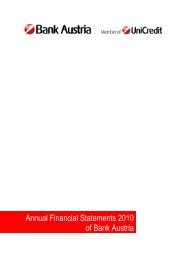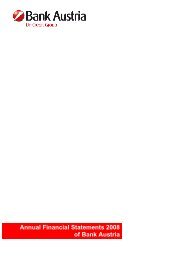Annual Financial Statements 2011 of Bank Austria
Annual Financial Statements 2011 of Bank Austria
Annual Financial Statements 2011 of Bank Austria
Create successful ePaper yourself
Turn your PDF publications into a flip-book with our unique Google optimized e-Paper software.
Management Report <strong>of</strong> UniCredit <strong>Bank</strong> <strong>Austria</strong> AG<br />
(allocation: € 489 bn / net <strong>of</strong> expiring transactions: + € 194 bn on<br />
that day). From the middle to the end <strong>of</strong> <strong>2011</strong>, the outstanding<br />
volume <strong>of</strong> open-market operations rose by 64% or € 233 bn. Use<br />
<strong>of</strong> the deposit facility was almost equally intensive. In the euro<br />
system, divergence between countries taking and placing funds<br />
became more pronounced.<br />
Interbank interest rates remained comparatively high. At year-end<br />
<strong>2011</strong>, the cost <strong>of</strong> three-month interbank money was 1.36%. The<br />
three-month Eonia swap (which limits default risk to compensation<br />
payments based on the interest rate swap) was almost 1<br />
percentage point lower, at 0.38%. The secured interest rate was as<br />
low as 0.14% (repo). Ultimately, three-month Treasury bills<br />
(German Bubills) even traded at a negative yield <strong>of</strong> 0.9%.<br />
Doubts about the power <strong>of</strong> determination <strong>of</strong> EU institutions and<br />
about the expansionary central bank policy pursued worldwide<br />
fuelled the strong rise in prices for precious metals and in the<br />
Swiss franc. In the crisis weeks <strong>of</strong> the third quarter, gold rose to an<br />
all-time high <strong>of</strong> US$ 1,920 per ounce; as institutional investors<br />
subsequently realised pr<strong>of</strong>its, the price <strong>of</strong> gold fell to US$ 1,564 per<br />
ounce at the end <strong>of</strong> <strong>2011</strong> (+10% year-on-year, +83% compared<br />
with year-end 2008). The Swiss central bank succeeded in<br />
stopping the rise <strong>of</strong> the Swiss franc (1.0085 CHF/EUR on 9<br />
August) by announcing unlimited intervention at a level <strong>of</strong> below<br />
1.20 CHF/EUR (closing rate at the end <strong>of</strong> <strong>2011</strong>: 1.2133 CHF/EUR,<br />
+2.9%). The US dollar more or less followed the interest rate<br />
differential, initially showing a weak trend (1.4939 USD/EUR on 4<br />
May <strong>2011</strong>). On the basis <strong>of</strong> expansionary central bank measures<br />
taken by the ECB, the US dollar strengthened to 1.2945 at the end<br />
<strong>of</strong> <strong>2011</strong>; at that level it was slightly up on a year earlier (+3.3).<br />
Recurrent media reports on the crisis led to widespread<br />
uncertainty among investors, which further reinforced the shift<br />
away from investments in mutual funds and shares. For example,<br />
the MSCI index <strong>of</strong> the BRIC stock markets at the end <strong>of</strong> <strong>2011</strong> was<br />
20% lower than at year-end 2010, and the MSCI index <strong>of</strong> CEE<br />
stock markets was down by 19%. The ATX index, in which banks<br />
have a strong weight, lost 36%. Jumbo mortgage bonds generated<br />
a performance <strong>of</strong> +3.8%, corporate bonds were weaker after two<br />
good years (+2.5%, non-financial, BBB). Commodities also showed<br />
a disappointing performance (–6.3%, Rogers, euro).<br />
In <strong>Austria</strong>, economic recovery proceeded at a surprisingly quick<br />
pace in the first half <strong>of</strong> <strong>2011</strong>. Growth picked up from 2.3% in 2010<br />
as a whole to over 4% in the first half <strong>of</strong> <strong>2011</strong>. It was driven by<br />
robust export demand, moderate growth <strong>of</strong> consumption and highly<br />
dynamic investment activity fuelled by a backlog <strong>of</strong> demand<br />
accumulated during the crisis. In summer, however, the loss <strong>of</strong><br />
confidence caused by the European government debt crisis started<br />
to have an impact on economic expectations. Capacity utilisation in<br />
the <strong>Austria</strong>n economy, which almost matched the multi-year<br />
average in the spring <strong>of</strong> <strong>2011</strong>, declined as the year progressed.<br />
After a strong recovery in which investment in equipment rose by<br />
an annual average <strong>of</strong> 8%, <strong>Austria</strong>n companies’ propensity to invest<br />
fell significantly. However, external uncertainty prevented domestic<br />
growth from becoming self-sustaining. Private consumption, on the<br />
other hand, increased moderately but steadily throughout the year,<br />
rising by less than 1 per cent in real terms although the labour<br />
market situation eased visibly. The number <strong>of</strong> employed persons in<br />
<strong>Austria</strong> was up by 1.8% on the previous year, reaching a new<br />
record level <strong>of</strong> over 3.4 million. Thanks to a mild winter in <strong>2011</strong>,<br />
employment trends did not yet reflect the economic slowdown. The<br />
unemployment rate declined from 4.4% to 4.2% in <strong>2011</strong>, though<br />
the improvement has recently come to a halt.<br />
Factors dampening consumption were the economic slowdown and<br />
the rise in inflation, caused by commodity prices, to an average<br />
level <strong>of</strong> 3.3% (2010: 1.9%), which did not ease until the end <strong>of</strong><br />
<strong>2011</strong>. Global demand, and in its wake also <strong>Austria</strong>n exports,<br />
weakened in the course <strong>of</strong> the year. Production in <strong>Austria</strong>’s exportoriented<br />
industrial sector therefore lost momentum and even<br />
entered a mild recessionary phase before the turn <strong>of</strong> the year.<br />
Based on the sharp upturn in 2010 and in the first few months <strong>of</strong><br />
<strong>2011</strong>, however, annual average rates <strong>of</strong> change were high: both<br />
exports and industrial output rose by over 7% in <strong>2011</strong>, strongly<br />
supporting the <strong>Austria</strong>n economy. Real GDP grew by 3.3%,<br />
making <strong>Austria</strong> one <strong>of</strong> the euro area countries which recorded the<br />
strongest growth in <strong>2011</strong>.<br />
Credit demand in <strong>Austria</strong> remained weak in <strong>2011</strong>. Nevertheless,<br />
this was the first year after 2009 and 2010 which saw growth<br />
(adjusted for CHF exchange rate effects) <strong>of</strong> just under 1.5%. While<br />
demand for residential construction loans was relatively robust,<br />
growing by about 4%, the volume <strong>of</strong> loans to small and mediumsized<br />
enterprises (SMEs) stagnated. In the area <strong>of</strong> consumer<br />
loans, repayments once again exceeded new business, leading to<br />
a decline <strong>of</strong> about 3% in total volume. Demand for corporate loans<br />
was slightly stronger: annual growth rose from 2% to 2.5%, mainly<br />
driven by developments in the second half <strong>of</strong> the year. Interest<br />
rates on deposits and loans in <strong>Austria</strong> rose in parallel with the<br />
increase in money market rates in <strong>2011</strong>. While margins had<br />
narrowed towards the end <strong>of</strong> 2010, this development did not<br />
continue in <strong>2011</strong>; the mark-up on money market rates was<br />
therefore lower, in annual average terms for <strong>2011</strong>, than in the<br />
previous year, especially for SME and housing loans. The same<br />
applies to deposit rates although interest rates in customer<br />
business rose much more strongly than money market rates<br />
towards the end <strong>of</strong> <strong>2011</strong>.<br />
With the economic recovery in <strong>2011</strong>, and as there were no major<br />
insolvencies during the year, insolvency liabilities fell sharply, by<br />
41%, and the number <strong>of</strong> insolvencies also declined by 8%. While<br />
the number <strong>of</strong> insolvencies <strong>of</strong> private households increased again,<br />
the related liabilities were lower than in the previous year.<br />
In <strong>2011</strong>, consumption probably continued to rise more strongly<br />
than incomes. The savings ratio declined significantly, from 8.4% to<br />
7.6%. This means that monetary capital formation <strong>of</strong> private<br />
households was as weak as in 2010. While bank deposits<br />
accounted for about one half <strong>of</strong> additions to financial assets, the<br />
total volume <strong>of</strong> deposits held by private households stagnated after<br />
the summer although deposit rates, unlike money market rates,<br />
increased slightly. Thanks to long-term contracts the life insurance<br />
sector recorded steady inflows <strong>of</strong> funds. The strong demand for<br />
bonds seen in the first six months <strong>of</strong> <strong>2011</strong> did not continue in the<br />
second half <strong>of</strong> the year. The net change in total volume <strong>of</strong><br />
investment certificates was negative in <strong>2011</strong>, after two years which<br />
saw net inflows.<br />
Central and Eastern Europe (CEE) did not completely escape the<br />
two major external influences, namely the economic slowdown in<br />
the second half <strong>of</strong> <strong>2011</strong> and the impact <strong>of</strong> the government debt<br />
crisis. Divergence among the regions and countries was<br />
pronounced, however. All countries were impacted by the<br />
slowdown in the European industrial sector in the latter half <strong>of</strong><br />
<strong>2011</strong>, but this development affected in particular the Central<br />
European countries, which are highly integrated in the production<br />
network. While exports <strong>of</strong> these countries rose strongly in the first<br />
few months, weaker growth in the second half <strong>of</strong> <strong>2011</strong> failed to be<br />
<strong>of</strong>fset by trends in domestic demand in view <strong>of</strong> the fiscal<br />
consolidation efforts made in all <strong>of</strong> these countries. In Hungary,<br />
special local factors dampened economic growth as in the previous<br />
year (real GDP <strong>2011</strong>: +1.6%).<br />
<strong>Bank</strong> <strong>Austria</strong> – <strong>Annual</strong> <strong>Financial</strong> <strong>Statements</strong> <strong>2011</strong> 186
















